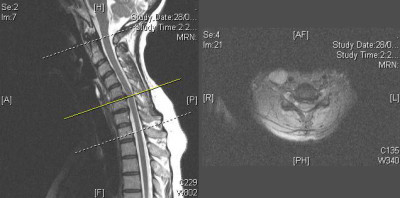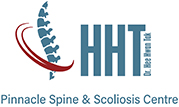Herniated Disc is a type of degenerative disc disease (DDD), which is a part of the natural process of growing older. Unfortunately, as we age, our intervertebral discs lose their flexibility, elasticity, and shock absorbing properties. The outer layers of the disc, called the annulus fibrosus, become brittle and they are more easily torn. At the same time, the soft gel-like center of the disc, called the nucleus pulposus, starts to dry out and shrink. However, not everyone who has degenerative changes in their cervical spine has pain. Many people who have no neck pain have MRI’s that show disc herniations, degenerative changes, and narrowed spinal canals.
Herniated Disc Symptoms
The common symptoms that suggest that degenerative disc disease may be responsible for a person’s pain include neck pain, pain that radiates down to the back of the shoulder blades or into the arms, numbness and tingling, and sometimes even difficulties with hand dexterity or walking. In severe cases of cervical DDD, where there is evidence of spinal cord compression, the patients may experience lower extremity weakness.
The diagnosis of degenerative disc disease begins with a complete physical examination of the neck, arms and lower extremities. X-rays will often show a narrowing of the spaces between the vertebral bodies, which indicates that the disc has become very thin or has collapsed. Bone spurs begin to form around the edges of the vertebral bodies and also around the edges of the facet joints in the spine. As the discs collapse and bone spurs form, the space available for the nerve roots and the spinal cord starts to shrink. The nerve roots leave the spinal canal through a bony tunnel called the neuroforamen, and it is at this point that the nerve roots are especially vulnerable to compression.
An MRI may also be done in order to assess the degenerative changes in the cervical spine. An MRI scan is very useful for determining where disc herniations (Figure 5) have occurred and where the nerve roots or spinal cord are being compressed.
Herniated Disc Treatment
The spine specialist will be able to discuss with you what your diagnosis means in terms of treatment options. For most patients, the first line treatment includes non-steroidal anti-inflammatory drugs and physiotherapy. Sometimes acupuncture may be offered.
Surgery for cervical spine disease is offered as an early option for people who have evidence of muscle weakness that is being caused by nerve root or spinal cord compression. This is because muscle weakness is a definite sign that the nerves are being injured (more seriously than when pain is the only symptom), and relieving the pressure on the nerves is more of an urgent priority. In other situations, surgery is offered after non surgical treatment has failed to adequately relieve the symptoms of pain, numbness and weakness.

Herniated disc is a common cause of neck pain. Learn more about the symptoms of Neck Pain, Non-surgical Treatment and Surgical Treatment for Neck Pain.
For a comprehensive consultation of your neck problems, contact us to make an appointment with our internationally experienced spine surgeon , Dr Hee Hwan Tak today. Visit Dr Hee Hwan Tak’s Google+ page here.
